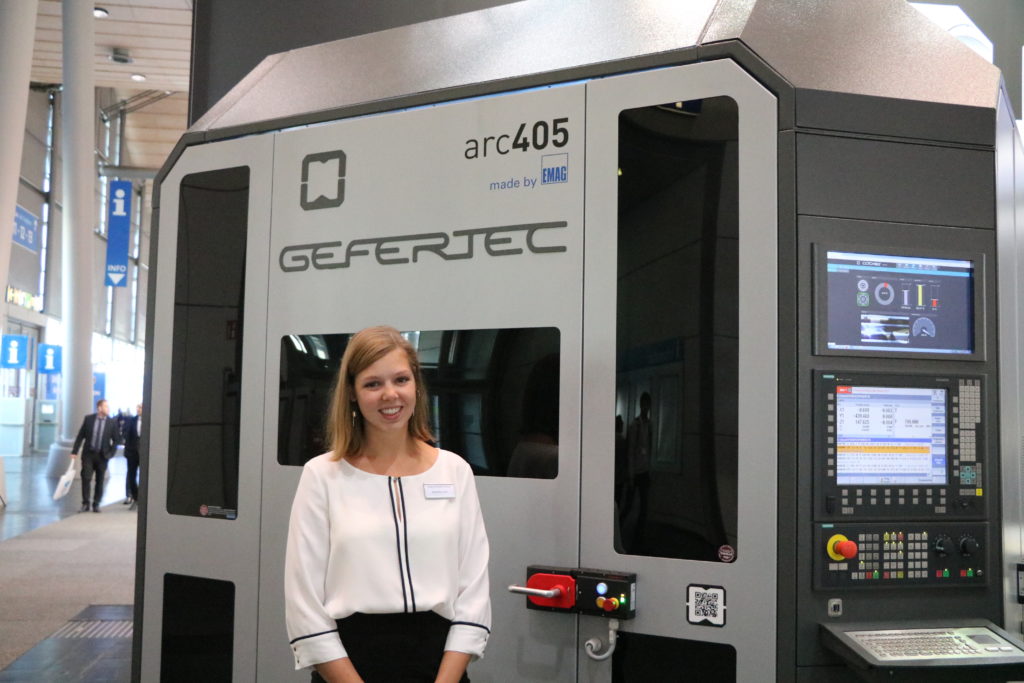For the 22nd edition of Emo Hannover, the organizer has allocated for the first time an area for additive manufacturing. Another way to invite the world of metalworking industry to consider this technology as part of their industrial production.
When I first looked at these companies in Hall 9, I was skeptical of the importance of their appearance on this exhibition. What value additive manufacturing can bring in a world that has acknowledged the potential of conventional metalworking processes? For several decades, companies have been leveraged these technologies and so far, everything seems to be working for the best for them. Then, I met Rebekka Jurtz from GEFERTEC, who saw things differently.

Jurtz first joined GEFERTEC as a student, in 2016, one year after the company was founded. She followed a combined degree in Mechanical Engineering and Economics. In other terms, she has the ability to easily understand the technical environment of a technology & the skills to make a business grow. – The best of both worlds.
GEFERTEC, on the other side, is a metal additive manufacturing company that delivers the market its 3DMP® process, a proprietary technology based on arc welding, using wire as a source material as opposed to powder. The company is definitely a fast-growing company, moving from 15 employees in 2016 to 40 employees today and surprisingly, Emo Hannover has played a key role in this development.
Why Emo Hannover?
According to Jurtz, when they were ready to show the industrial world their technology, GEFERTEC chose Emo Hannover as their first platform of exhibition. That was in 2017. Additive manufacturing still raised a lot of questions at the time. Therefore, bringing this technology in an area that is not familiar at all with this technology was a double risk for the company, a risk that was ultimately worth it for GEFERTEC.
“Emo was the right choice for our first appearance in public, because we wanted people to choose between a milling machine and a metal 3D Printing machine. We do not compete with other metal AM technologies, we compete with milling, casting & forging processes. Furthermore, in an additive manufacturing dedicated show, professionals are more advanced when it comes to manufacturing technologies. Most of those who participate in such type of shows already have an idea of what they are looking for. At Emo, the vision is still different and we needed to show professionals another way of thinking. One company cannot achieve it alone. That’s the reason why, we are also happy to see other AM companies in this corner”, explained Jurtz.
In 2017, GEFERTEC collected thousands of leads. During this edition, they still had a lot of leads but people’s mindset was slightly different. According to the Sales & Marketing Manager, there was less surprise in the eyes of visitors who discovered their technology compared to 2017.
A different metal 3D Printing process
Metal AM is one of the most fascinating sides of additive manufacturing. A technology overview already shows more than 13 different types of metal 3D Printing technologies. However, when talking about metal additive manufacturing, “professionals believe that powder-bed fusion technology is the only technology that exists”, said the Sales & Marketing Specialist.
Reality shows that most companies that supply metal AM, specialize in powder-based feedstock systems while wire-based AM technology also offers a viable alternative to traditional manufacturing, with use cases in the same demanding industries such as aerospace, marine, automotive and architecture.

Furthermore, just like powder-based technologies, we also found several types of wire-based technologies in metal AM: resistance welding, plasma arc energy depositioning, electron beam energy depositioning, wire feed laser energy deposition & wire arc energy depositioning.
GEFERTEC supplies wire arc energy depositioning. A live demo at Emo enabled me to see that this process melts metal wire using an electric arc as the heat source. Further explanations reveal that when melted, the wire is extruded in the form of beads on the substrate. As the beads bond together, they create a layer of metal material. The process is afterwards repeated until the metal part is formed.
GEFERTEC’s spokesperson explained that the company offers the market a three into one solution that combines machine, process and software. To date, the company includes 4 types of systems in its portfolio: arc603, arc605, arc403 & arc 405. Moreover, one attributed of this process is that wire feedstock is offered as a supply material for metal additive manufacturing.
While comparing the benefits of their technology with PB-F technologies, the mechanical engineer declared:
- Their technology is cheaper than the other metal AM process. The welding wire used in wire arc energy depositioning is less expensive than the metal powder used in powder-based metal AM systems.
- The use of raw materials makes the technology easier to implement, not to mention that they are only deposited where needed.
However, as nothing is perfect, the specialist also revealed that despite their technology ability to manufacture large-scale metal parts, their technology does not produce yet complex bionic structures. Furthermore, the surface of the printed part remains rough hence the need of post-processing.
Lastly, even though additive manufacturing in general advances at a fast pace, Jurtz deplores a certain economic crisis in the industry that does not help professionals who are already afraid, to cross the line of additive manufacturing.
You can now post free of charge job opportunities in the AM Industry on 3D ADEPT Media. For further information about 3D Printing, follow us on our social networks and subscribe to our newsletter : Facebook, Twitter, LinkedIn & Instagram !Would you like to be featured in the next issue of our digital magazine? Send us an email at contact@3dadept.com
https://pagead2.googlesyndication.com/pagead/js/adsbygoogle.js
(adsbygoogle = window.adsbygoogle || []).push({});


